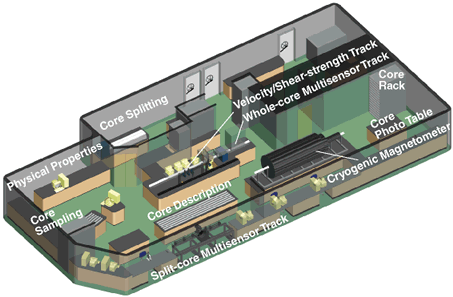JOIDES Resolution Tour 1985–2005
JOIDES Resolution: Bridge Deck/Level 6
Lab layout of the JOIDES Resolution
After the cores (up to 9.5 m-long) are recovered on the rig floor, they are carried to the catwalk just forward of the rig floor. On the catwalk, the core is labelled and cut into 150-cm sections. In addition, samples for hydrocarbon safety monitoring, interstitial water chemistry, and physical properties are collected.

The core sections are then moved into the Core Lab where they are permanently labelled and their information is entered into a database to initiate the curation and core-sample tracking process. After the cores equilibrate to room temperature, the whole-round core sections are subjected to thermal conductivity measurements and then passed through the multisensor track, which measures bulk density, P-wave velocity, magnetic susceptibility, and natural gamma radiation.
The cores are then cut into archive and working halves. The archive half is used for non-destructive description and analyses such as visual core descriptions, whole-core and close-up photography, and paleomagnetic analysis. The working half is measured for physical properties and sampled for shipboard and postcruise scientific research.
The main equipment of the Paleomagnetism Lab is a 2G Enterprises cryogenic magnetometer, which employs superconductivity to make highly sensitive, nondestructive measurements of the natural remanent magnetization of the archive-half core sections. The data for all sections from a single hole can be concatenated to give a picture of the changing polarity of the Earth's magnetic field over time. The combination of the paleomagnetic data with paleontologic data provides critical dating of the sediments while still at sea. The lab also includes a variety of equipment designed for the measurement and demagnetization of discrete samples, which provide important information about the types of magnetic minerals and the fabric of the sediments.
The Physical Properties Lab includes a variety of instruments for measuring physical properties. The multisensor track continuously measures magnetic susceptibility, P-wave velocity, density, and natural gamma radiation of unsplit core sections. Shear strength is measured with the Vane Shear apparatus, density and porosity are determined using a pycnometer, and thermal conductivity is measured using the needle probe method.
Core description is conducted between the Physical Properties and Paleomagnetism Labs. Its most prominent feature are two large tables for assembling the archive- and working-half sections of each core. This is where the sedimentologists, petrologists, and structural geologists make comprehensive visual descriptions of the recovered cores. The lab contains materials for smear-slide preparation as well as a few microscopes. A digital color spectrophotometer is used for high-resolution color profiles of each core section.
Core samples are identified and extracted from the cores next to the core description area. The Curator is responsible for all aspects of core curation and sampling, and provides training and guidance for the scientists who take the samples.
A photographic table for whole-core photography and a stand for close-up photography are located adjacent to the Paleomagnetism Lab.
The cores are stored in a refrigerator until the end of the cruise when they are shipped to one of IODP's Core Repositories.